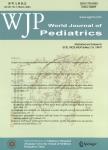Hematopoietic stem cell transplantation for children with β-thalassemia major: multicenter experience in China
Hematopoietic stem cell transplantation for children with β-thalassemia major: multicenter experience in China作者机构:Guangdong Provincial Key Laboratory of MalignantTumor Epigenetics and Gene RegulationMedical ResearchCenter(Pediatrics)Medical Research CenterSun Yat-SenMemorial HospitalSun Yat-Sen UniversityGuangzhouChina Department of HematologyGuangzhou Womenand Children’s Medical CenterGuangzhou MedicalUniversityGuangzhouChina Department of HematologyShanghai Children’s MedicalCenterShanghai Jiaotong University School of MedicineShanghaiChina
出 版 物:《World Journal of Pediatrics》 (世界儿科杂志(英文版))
年 卷 期:2018年第14卷第1期
页 面:92-99页
核心收录:
学科分类:1004[医学-公共卫生与预防医学(可授医学、理学学位)] 1002[医学-临床医学] 100214[医学-肿瘤学] 10[医学]
基 金:a Clinical Key Discipline(the Subtropical Disease Center for Thalassemia)from the Chinese Ministry of Health(1311200006107) National Natural Science Foundation of China(81100370 and 81370603).
主 题:β-Thalassemia major Hematopoietic stem cell transplantation Umbilical cord blood
摘 要:Backgroundβ-Thalassemia major (β-TM) has become a public health problem in China s Mainland. Hematopoietic stem cell transplantation (HSCT) has remained the only cure forβ-TM in China s Mainland since 1998. Methods This multicenter retrospective study provides a comprehensive review of the outcomes of 50 pediatric patients withβ-TM who received HSCT between 1998 and 2009 at five centers in China s Mainland. Both related (n = 35) and unrelated donors (n = 15) with complete human leukocyte antigen matches were included. The stem cell sources included bone mar-row (BM), peripheral blood stem cells, umbilical cord blood (UCB) and a combination of BM and UCB or a combination of BM and peripheral blood stem cells from a single sibling donor. Results The probabilities of 5-year overall survival (OS) and thalassemia-free survival (TFS) after the first HSCT were 83.1 and 67.3%, respectively. Graft failure (GF) occurred in 17 patients. Univariate analyses showed that umbilical cord blood transplantation (UCBT) was one of the potential risk factors for decreased OS (P = 0.051), and that UCBT (P = 0.002) was potentially related to TFS. GF incidence was distinct between the UCBT and non-UCBT groups (P = 0.004). Four cases of UCB-BM combined transplantation led to decreased risks of mortality and recurrence. In the UCBT group, related donor transplantation produced more favorable results than unrelated donor transplantation in OS (P = 0.009) but not in TFS (P = 0.217). Conclusions GF was the primary cause of UCBT failure. Though UCBT from related donors was not favorable, the combined transplantation of UCB and BM could improve the prognosis of UCBT.



